


3.4. Transfer Functions for a Variety of Simple Models
The simple analytic calculation in the last section was intended to be illustrative and serve as a reference point. We will now expand on this with more general geometries, and also incorporate information from Doppler motion along the line of sight. We will derive some transfer functions for other simple models, focusing on three: (a) systems of clouds in circular Keplerian orbits, illuminated by an isotropic continuum, (b) biconical outflows, and (c) disks of random inclination. All these are physically plausible, and can produce "double-peaked" emission-line profiles, which are sometimes seen in AGNs, though not all of these models necessarily do this. We will start with the simplest models and progress to more complicated models. Much of this discussion is drawn from discussions of transfer functions in the literature 93, 60, 24, 30, 31 .
Suppose line-emitting clouds are on a circular orbit
at inclination i = 90°; imagine that the circle
in Fig. 7a represents this orbit
seen face on. The line response from the
clouds at the intersection of an arbitrary isodelay surface
and the circular orbit
will be at time delay  = (1 +
cos
= (1 +
cos  ) r/c and
line-of-sight velocities Vz = ±
Vorb sin
) r/c and
line-of-sight velocities Vz = ±
Vorb sin ,
where Vorb = (GM / r)1/2, the
circular orbital speed.
It is easy to see that the circular orbit projects to
an ellipse in the line-of-sight velocity/time-delay
(Vz,
,
where Vorb = (GM / r)1/2, the
circular orbital speed.
It is easy to see that the circular orbit projects to
an ellipse in the line-of-sight velocity/time-delay
(Vz,  ) plane
with semiaxes Vorb and r/c,
as shown in Fig. 7b. This simple
example is important because it is straightforward to generalize
it to both disks (rings of different radii) and
shells (rings at different inclinations).
) plane
with semiaxes Vorb and r/c,
as shown in Fig. 7b. This simple
example is important because it is straightforward to generalize
it to both disks (rings of different radii) and
shells (rings at different inclinations).
First we consider the generalization to a shell. We can construct
a shell from a distribution of circular orbits, with inclinations
ranging from i = 0° to i = 180°. As we decrease the
inclination of the circular orbit in
Fig. 7a from
i = 90°, we see that the range of time delays will
decrease from [0, 2r/c] to [(1-sin i) r/c, (1 + sin
i) r/c],
and similarly the line-of-sight velocity range will decrease from
[-Vorb, +Vorb] to
[-Vorbsin i, +Vorbsin i],
as we show schematically in Fig. 8.
At the limiting
case i = 0°, the time delays all contract to r/c, since
the light travel-time paths for all points on a face-on ring are
the same, and the velocities all contract to
Vz = 0, because the orbital velocities are now
perpendicular to the line of sight. Thus, the transfer
function looks like a series of ellipses as in
Fig. 8b
that with decreasing inclination
contract down to a single point at Vz = 0 and
 = r/c
when i = 0°.
We can construct such a transfer function
by using a Monte Carlo method that places BLR clouds
randomly across the surface of the shell, and the result
we get is shown in Fig. 9,
which corresponds to a thin shell of
radius 10 light days and a central mass of 108
M
= r/c
when i = 0°.
We can construct such a transfer function
by using a Monte Carlo method that places BLR clouds
randomly across the surface of the shell, and the result
we get is shown in Fig. 9,
which corresponds to a thin shell of
radius 10 light days and a central mass of 108
M . We
have also integrated this transfer function over
. We
have also integrated this transfer function over
 and Vz to
obtain the emission-line
profile and the one-dimensional transfer function, respectively.
In the particular case of a thin spherical shell, we see
that both of these are simple rectangular functions,
as we showed analytically for the one-dimensional transfer
function (Eq. (26)).
and Vz to
obtain the emission-line
profile and the one-dimensional transfer function, respectively.
In the particular case of a thin spherical shell, we see
that both of these are simple rectangular functions,
as we showed analytically for the one-dimensional transfer
function (Eq. (26)).

|
Figure 8. Here we take the circular ring
shown in Fig. 7 and show how its
projection on
Vz, |

| (27) |
where  0 is
constant and the parameter A = 0 for isotropic emission
and A = 1 for completely anisotropic emission; the latter
case is appropriate for spherical clouds
with inward-facing surfaces that are uniformly bright.
In principle, A can be estimated by photoionization
modeling, though in practice the values are highly
uncertain on account of limitations in the accuracy
of the radiative transfer codes (see the contribution by Netzer).
It is certainly expected that A
0 is
constant and the parameter A = 0 for isotropic emission
and A = 1 for completely anisotropic emission; the latter
case is appropriate for spherical clouds
with inward-facing surfaces that are uniformly bright.
In principle, A can be estimated by photoionization
modeling, though in practice the values are highly
uncertain on account of limitations in the accuracy
of the radiative transfer codes (see the contribution by Netzer).
It is certainly expected that A
 1 for
Ly
1 for
Ly ,
at least, and models suggest approximate values
A
,
at least, and models suggest approximate values
A  0.7 for C IV and
A
0.7 for C IV and
A  0.8 for
H
0.8 for
H 24 .
The main effect of anisotropic emission is to increase
the measured lag for a given geometry because the
apparent response of the near side of the BLR is
suppressed. For a thin shell of radius r, the
mean time delay is
24 .
The main effect of anisotropic emission is to increase
the measured lag for a given geometry because the
apparent response of the near side of the BLR is
suppressed. For a thin shell of radius r, the
mean time delay is  = (1 +
A / 3) r/c. Fig. 10
shows the transfer function for the same thin spherical
shell model of Fig. 9, but in this case with highly
anisotropic (A = 1) line response.
= (1 +
A / 3) r/c. Fig. 10
shows the transfer function for the same thin spherical
shell model of Fig. 9, but in this case with highly
anisotropic (A = 1) line response.

|
Figure 10. Transfer function for a thin spherical shell, as in Fig. 9, except with completely anisotropic (A = 1) line emission, i.e., all of the emission line flux from each cloud is directed back towards the continuum source. |
In addition to anisotropic line response, we can
also consider anisotropic illumination of the BLR
clouds by the continuum source.
As an example, consider the case where BLR
clouds are illuminated by biconical beams of
semi-opening angle  ; the
limiting case as
; the
limiting case as
 approaches zero would be a
narrow jet-like pencil beam, and the case
approaches zero would be a
narrow jet-like pencil beam, and the case
 = 90° corresponds
to an isotropic continuum. We
start by examining the response of an edge-on
(i = 0°) circular ring, as we show in
Fig. 11,
which is exactly like Fig. 7, but
with only
part of each orbit illuminated by the continuum source.
We earlier generalized the result for a shell,
going from to
Fig. 8
as we decreased the inclination of the ring; doing this again, we see
in Fig. 12 how the two-dimensional transfer
function is altered by anisotropic illumination. We note specifically
the absence of any response near
= 90° corresponds
to an isotropic continuum. We
start by examining the response of an edge-on
(i = 0°) circular ring, as we show in
Fig. 11,
which is exactly like Fig. 7, but
with only
part of each orbit illuminated by the continuum source.
We earlier generalized the result for a shell,
going from to
Fig. 8
as we decreased the inclination of the ring; doing this again, we see
in Fig. 12 how the two-dimensional transfer
function is altered by anisotropic illumination. We note specifically
the absence of any response near
 = 0 and
= 0 and
 = 2r/c since the bicones
shown do not illuminate
BLR clouds directly along the observer's axis. Similarly there is
also no response around
= 2r/c since the bicones
shown do not illuminate
BLR clouds directly along the observer's axis. Similarly there is
also no response around  =
r/c due to the absence
of response of clouds at
=
r/c due to the absence
of response of clouds at 
 90°.
90°.

|
Figure 11. A ring-like line-emitting region
and its projection
into the Vz, |
So far we have restricted our attention to "thin" geometries, i.e., single orbits and shells. Generalization to "thick" geometries, e.g., disks and shells with different inner and outer radii, is trivial: the response of a disk can be computed by integrating over a series of circular orbits, and the response of a thick shell is obtained by integrating over a series of shells. In Fig. 13, we illustrate this concept by showing the response from two rings.

|
Figure 12. Transfer function for a thin
spherical shell,
as in Fig. 9, except with an anisotropic
continuum source. In the example shown, the beam
opening angle is |

|
Figure 13. Two ring-like regions (as in
Fig. 7),
and their projected response on the (Vz,
|
Thus far, the free parameters we
have dealt with are the radius r, the line anisotropy
factor A, and in the case of non-spherically symmetric
systems, the inclination i and, in the case of
biconical illumination, the beam half-angle
 .
Thick geometries now introduce inner and outer radii,
rin and rout, respectively, and
a distance-dependent responsivity per unit volume
(or per unit area, for a disk), which we can parameterize as
.
Thick geometries now introduce inner and outer radii,
rin and rout, respectively, and
a distance-dependent responsivity per unit volume
(or per unit area, for a disk), which we can parameterize as
 (r)
(r)

 0
r
0
r . The
index
. The
index  allows us to condense
model-dependence into a single parameter that
will account for effects due to
geometrical r-2 dilution of the continuum, a
distance-dependent covering factor, etc.
In Figs. 14 and 15
we show transfer functions
for thick spherical shell systems with A = 0 and identical
values of rin and rout, but differing
radial-response indices
allows us to condense
model-dependence into a single parameter that
will account for effects due to
geometrical r-2 dilution of the continuum, a
distance-dependent covering factor, etc.
In Figs. 14 and 15
we show transfer functions
for thick spherical shell systems with A = 0 and identical
values of rin and rout, but differing
radial-response indices  ; the
effect of increasing
; the
effect of increasing
 is to enhance the relative
response of material at larger radii; the limiting cases where
is to enhance the relative
response of material at larger radii; the limiting cases where
 ->
-
->
- and
and
 ->
+
->
+ correspond to the response
functions of thin shells of radius rin and
rout, respectively. We will show additional examples
below.
correspond to the response
functions of thin shells of radius rin and
rout, respectively. We will show additional examples
below.

|
Figure 14. Transfer function for a thick
spherical shell
with rin = 2 lt-days, rout = 10
lt-days, and radial responsivity index
|
We consider now a thick shell system that is illuminated
by an anisotropic continuum source. Again, we assume that the
line-emitting clouds are in circular Keplerian orbits of
random inclination. We show examples that are identical except
for the continuum beam width and inclination in
Figs. 16 and 17. An
important thing to notice is that in one case
(Fig. 16) the
observer is outside of the continuum beam (i.e., i >
 ) and
in the other case (Fig. 17) the
observer is inside of the continuum beam (i.e., i <
) and
in the other case (Fig. 17) the
observer is inside of the continuum beam (i.e., i <
 );
when the observer is inside the beam, the line profile
is single-peaked, and when the observer is outside
the beam, the line profile is double-peaked.
);
when the observer is inside the beam, the line profile
is single-peaked, and when the observer is outside
the beam, the line profile is double-peaked.
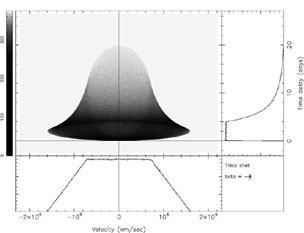
|
Figure 15. Transfer function for a thick
spherical shell
exactly as described in Fig. 14, except with
radial responsivity index |
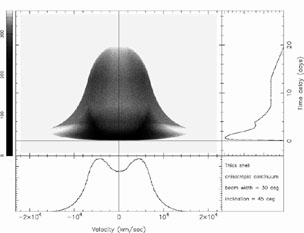
|
Figure 16. Transfer function for a thick
spherical shell
with rin = 2 lt-days, rout = 10
lt-days, radial responsivity index
|
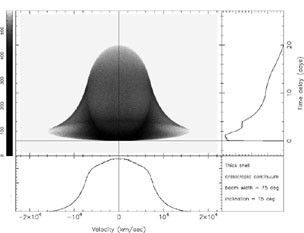
|
Figure 17. Transfer function for a thick
spherical shell
exactly as described in Fig. 16,
except that in this model the shell is illuminated by a biconical
continuum with semi-opening angle
|
Another simple kinematic model for the BLR consists of clouds
in spherical outflow. The transfer functions for such cases
are quite distinctive; an example of a two-dimensional tranfer
function for a kinematic field with radial velocity
Vr  r for r less than some maximum distance
rout is shown in Fig. 18.
This velocity field corresponds to either a ballistic outflow
or a flow undergoing constant acceleration. At
r for r less than some maximum distance
rout is shown in Fig. 18.
This velocity field corresponds to either a ballistic outflow
or a flow undergoing constant acceleration. At
 = 0 we see response from all
the material along the
line of sight to the continuum source, which ranges
from Vz = 0 for the material closest to the central source
to Vz = -V(rout) for the gas
farthest from the continuum
source. As
= 0 we see response from all
the material along the
line of sight to the continuum source, which ranges
from Vz = 0 for the material closest to the central source
to Vz = -V(rout) for the gas
farthest from the continuum
source. As  increases, we begin
to see response from the
far side of the BLR where the line of sight velocities Vz
become positive. The range of line-of-sight velocities
decreases as the isodelay surfaces get farther from the
line of sight. At
increases, we begin
to see response from the
far side of the BLR where the line of sight velocities Vz
become positive. The range of line-of-sight velocities
decreases as the isodelay surfaces get farther from the
line of sight. At  =
rout / 2, the isodelay surface
no longer crosses any clouds moving towards the observer,
and the gas moving fastest away from the observer is that
along the line of sight (
=
rout / 2, the isodelay surface
no longer crosses any clouds moving towards the observer,
and the gas moving fastest away from the observer is that
along the line of sight ( =
0) with Vz = V(rout) / 2. At
=
0) with Vz = V(rout) / 2. At
 = 2rout /
c, only the response from the antipodal point is seen, and the
transfer function is contracted to the single point
at [2rout / c, V(rout)].
= 2rout /
c, only the response from the antipodal point is seen, and the
transfer function is contracted to the single point
at [2rout / c, V(rout)].
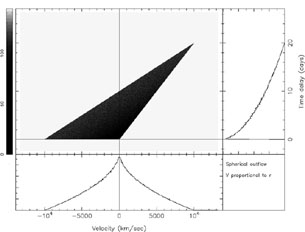
|
Figure 18. Transfer function for a
spherical outflow, with outflow velocity V
|
The case of biconical outflows (which are possibly relevant,
as they are certainly seen in the NLR and might well apply
to at least a component of the BLR) can be
dealt with by restricting the response to certain values
of  ; an example is shown in
Fig. 19.
; an example is shown in
Fig. 19.
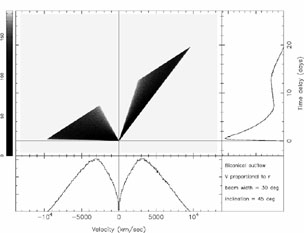
|
Figure 19. Transfer function for a
biconical outflow,
with parameters as in Fig. 18 except
that the outflowing gas is confined to a bicone
of half-width |
We have now seen that both orbital and outflow models
can produce similar emission-line profiles; if the
line-emitting gas is confined to a bicone, either
because of the gas distribution or the ionizing-photon
distribution, one can get a single-peaked or double-peaked
line profile. The two situations can be easily distinguished,
however, by their two-dimensional transfer functions
(or equivalently, the combination of their one-dimensional
transfer functions and their line profiles).
In Fig. 20, we directly compare the one-dimensional
transfer functions and line profiles for two thick-shell
models: (1) emission-line clouds in a biconical outflow
and (2) clouds in circular Keplerian orbits of
random inclination, illuminated by a biconical
continuum source. In both cases, the beams (one
radiation, one matter) have the same half-opening
angle ( = 40°) and two
different inclinations
are shown; i = 25° in the top row
(i.e. the observer is in the beam, as indicated in the left-hand
column illustrations of the geometry), and
i = 65° in the bottom row (i.e., the observer is out
of the beam). The distribution of line-emitting clouds is the
same, regardless of how the clouds are moving, so in these
two cases the one-dimensional transfer functions ought to be
very similar, which is indeed the case, as seen in the middle column of
Fig. 20. The right-hand column shows the
line profiles, which are however very different. Consider the
case i = 25° (top row): in the case of outflow, the
line-emitting material in the beam is moving radially
outward, giving relatively highly
blueshifted (near side) and redshifted (far side) emission,
but little emission near Vz = 0, since there is no
line-emitting material moving transverse to the line of
sight. In the case of clouds in circular orbits illuminated
by an anisotropic beam, the cloud motions are perpendicular
to their radial vectors, so most of the line-emitting material
is at low Doppler shift as the gas motions through
the beams are predominantly transverse. Now consider the
higher-inclination case (i = 65°; bottom row): in the
case of radial outflow, the gas motions in this case are now
primarily transverse so the Doppler shifts are smaller.
However, in the case of circular orbits, the material in
the beam is moving primarily along the line of sight, and
there is a deficiency of material at Vz
= 40°) and two
different inclinations
are shown; i = 25° in the top row
(i.e. the observer is in the beam, as indicated in the left-hand
column illustrations of the geometry), and
i = 65° in the bottom row (i.e., the observer is out
of the beam). The distribution of line-emitting clouds is the
same, regardless of how the clouds are moving, so in these
two cases the one-dimensional transfer functions ought to be
very similar, which is indeed the case, as seen in the middle column of
Fig. 20. The right-hand column shows the
line profiles, which are however very different. Consider the
case i = 25° (top row): in the case of outflow, the
line-emitting material in the beam is moving radially
outward, giving relatively highly
blueshifted (near side) and redshifted (far side) emission,
but little emission near Vz = 0, since there is no
line-emitting material moving transverse to the line of
sight. In the case of clouds in circular orbits illuminated
by an anisotropic beam, the cloud motions are perpendicular
to their radial vectors, so most of the line-emitting material
is at low Doppler shift as the gas motions through
the beams are predominantly transverse. Now consider the
higher-inclination case (i = 65°; bottom row): in the
case of radial outflow, the gas motions in this case are now
primarily transverse so the Doppler shifts are smaller.
However, in the case of circular orbits, the material in
the beam is moving primarily along the line of sight, and
there is a deficiency of material at Vz
 0.
0.
Note that either kinematic field can give either
double-peaked or single-peaked profiles: a simple
generalization is that double-peaked profiles are
produced in outflow models when the observer's line-of-sight
is in the beam (i.e., i

 )
and in orbital models when the line of sight
is out of the beam (i
)
and in orbital models when the line of sight
is out of the beam (i

 ). Neither the profiles
nor the one-dimensional transfer functions individually tell us
much about the BLR kinematics and velocity field,
but together they can tell us a lot.
Information on both
). Neither the profiles
nor the one-dimensional transfer functions individually tell us
much about the BLR kinematics and velocity field,
but together they can tell us a lot.
Information on both  and
Vz, i.e.,
the two-dimensional transfer function, greatly reduces the
ambiguities.
and
Vz, i.e.,
the two-dimensional transfer function, greatly reduces the
ambiguities.
Finally, for completeness, we consider the case of an inclined disk, as this is the classic geometry for producing a double-peaked line profile. The response of a disk-like BLR can be computed by integrating the response of rings of different radii. In Fig. 21, we show the transfer function and line profile for a disk at intermediate inclination (i = 45°). Identical line profiles can be obtained for different inclinations simply by suitably adjusting the central mass, but the transfer function allows us to reduce the ambiguity between possible disk models.